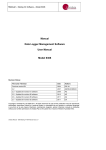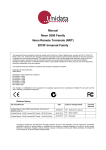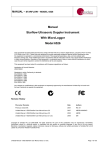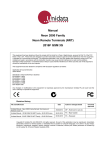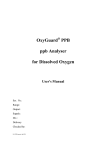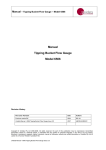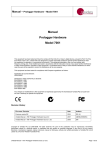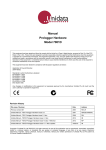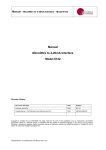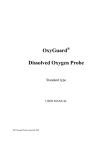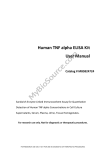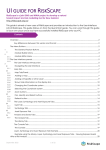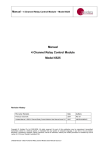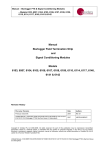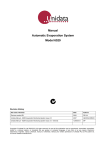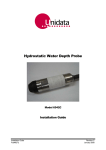Download Manual Oxyguard Probe Model 7422A
Transcript
Manual Oxyguard Probe Model 7422A This equipment has been tested and found to comply with the limits for a Class A digital device, pursuant to Part 15 of the FCC Rules in the U.S.A. These limits are designed to provide reasonable protection against harmful interference when the equipment is operated in a commercial environment. This equipment generates, uses, and can radiate radio frequency energy and, if not installed and used in accordance with the instruction manual, may cause harmful interference to radio communications. Operation of this equipment in a residential area is likely to cause harmful interference in which case the user will be required to correct the interference at his own expense. This equipment has been tested for compliance with European regulations as follows: Application of Council Directive: 2004/108/EC Standards to which Conformity is declared: EN-61000-6-1:2001 EN-61000-4-2:1995 EN-61000-4-3:1995 EN-61000-4-4:1995 EN-61000-4-6:1996 ENV-50204:1995 Any changes or modifications to this equipment not expressly approved by the manufacturer Unidata Pty Ltd could void the user’s authority to operate this equipment. Revision History File name / Revision Date Author & Change Detail Previous version BX 2004 RS/ JH Unidata Manual - 7422 Oxyguard Probe Issue 2.0 2007 AB/CB/JH/MS/KC Manual reformat 2013 MP Unidata Manual - 7422A Oxyguard Probe Issue 4.0.docx 30 01 15 IM,CB Content Update Checked / Approved CB Copyright © Unidata Pty Ltd 2000-2013. All rights reserved. No part of this publication may be reproduced, transmitted, transcribed, stored in a retrieval system, or translated into any spoken or computer language, in any form or by any means. Electronic, mechanical, magnetic, optical, chemical, manual or otherwise, without prior written permission of Unidata Pty Ltd 40 Ladner St, O’Connor Western Australia 6163. Manual – Oxyguard Probe Model 7422A TABLE OF CONTENTS 1.0 INTRODUCTION................................................................................................................... 1 2.0 PROGRAMMING STARLOG ............................................................................................... 2 3.0 CALIBRATION ..................................................................................................................... 4 Calibration Procedure for % Saturation Measurement ........................................................ 4 Calibration method for oxygen-content (mg/l) ..................................................................... 5 3.1 3.2 Unidata Manual - 7422A Oxyguard Probe Issue 4.0.docx Contents 1 Manual – Oxyguard Probe Model 7422A 1.0 INTRODUCTION This manual is a supplement to the Owner’s Manual supplied with the OxyGuard® Dissolved Oxygen Probe. It describes: • How to use the Model 7422A Oxygen Probe with Unidata dataloggers • How to connect the oxygen probe to Unidata dataloggers • How to make adjustments to the Starlog V4 Program • The oxygen probe is manufactured by the company OxyGuard®. For info on storage and probe maintenance please refer to manufacturer web site: http://www.oxyguard.dk/downloads-a-service The oxygen probe is a galvanic measuring element with built-in temperature compensation. Its output is proportional to the oxygen concentration. The output signal is connected via a galvanic isolation module to a Unidata datalogger. The connection cable supplied is 5m long. It can be extended to 100m. The wires are: - Pol Blue wire + Pol Brown wire The sensor requires no external power supply, little maintenance, and is very robust. It can be used in water depths up to 100m (the 5m cable can be lengthened). The oxygen diffuses through a robust membrane that must be cleaned at regular intervals with a soft cloth. General refurbishment is recommended every 1 to 2 years. The sensor uses very little oxygen and also functions in flows of only 2cm/sec. In its standard form it measures the dissolved oxygen in terms of %-saturation (standard). By changing the membrane it can measure oxygen content in mg/l (optional). The OxyGuard probe is easy to install. It should be placed where there is some movement in the water. 1cm/s is enough at 7mg/l and a water temperature of 13°C. Unidata Manual - 7422A Oxyguard Probe Issue 4.0.docx Page 1 Manual – Oxyguard Probe Model 7422A 2.0 PROGRAMMING STARLOG 1. Launch StarlogV4, Select Scheme Editor from the menu. 2. Select New (scheme) and select logger type (Double Click) 3. Select Instruments and click on NIWA Instrument library, choose analogue sensor Unidata Manual - 7422A Oxyguard Probe Issue 4.0.docx Page 2 Manual – Oxyguard Probe Model 7422A 4. Double click on the Analogue Sensor #1 instrument and Edit as follows: 5. Select Log buffer and select log rate and the data to record. Unidata Manual - 7422A Oxyguard Probe Issue 4.0.docx Page 3 Manual – Oxyguard Probe Model 7422A 3.0 CALIBRATION You should calibrate the oxygen probe before using it the first time and then at regular intervals (say 3 to 6 months). The calibration values are entered in the Starlog program. Calibration involves immersing the probe in a fluid with known gas or oxygen content, and then reading the output signal. You can use saturated water or air while the probe is connected to a data logger. To determine the calibration value for systems measuring % saturation, place the probe in air or in 100% air saturated water. Ambient temperature, barometric pressure and water salinity should be taken into account when measuring the oxygen content (mg/l). The output signal of the oxygen probe is proportional to the oxygen concentration. It is approximately 40mV for the % saturation type (standard version) and approximately 50mV in air for the mg/l (ppm) type (optional). To measure this small voltage accurately, the data logger must be set to a suitable measurement range. With the Starlog V4 Program this happens automatically when you run the procedure “Program Logger with Scheme” 3.1 Calibration Procedure for % Saturation Measurement The calibration procedure is based on a single point measurement. For systems measuring % saturation this point is always 100%. Just hold the sensor in the air, let the sensor adjust to the ambient temperature and then determine the output signal. The zero point is always zero (0mV). Note: the adjustment to ambient temperature can take from ten minutes to one hour. 1. Take the oxygen probe out of the water, wipe the membrane dry, and hang it in the air away from direct sunlight (if necessary wrap aluminium foil around it) until it adjusts to the ambient temperature. 2. Connect the data logger to the computer and start the Starlog V4 Program. 3. Program the data logger with a Scheme and then select Scheme Test Mode. 4. Observe the output of the oxygen probe on the screen. In air the reading should be 100%. 5. If the difference is too large, choose Logger > Test Display. The voltage measured by the data logger will be displayed in a new window. 6. Observe the channel number for the oxygen probe (example: A7). Hint: when you move the new window, the window with the actual measured oxygen value will also be visible. Note the value of the particular channel number (example: A7 = 372) and divide this value by 10. The new calibration point will be 100% saturation = 37.2mV. Unidata Manual - 7422A Oxyguard Probe Issue 4.0.docx Page 4 Manual – Oxyguard Probe Model 7422A To enter the calibration point into the scheme: 3.2 1. Select Screen, Exit, System, Scheme Editor, Window, Instruments, Edit. 2. Choose the oxygen probe and note the old calibration value before substituting a new one. 3. Correct the calibration value to account for water temperature, barometric pressure and water salinity using tables from OxyGurad user manual. 4. Change the entry under Output, Max. to the new calibration value, without changing the entry under Scale a:/b:. 5. Save the scheme. 6. Program the data logger and then choose Scheme Test mode to check the new entries. Calibration method for oxygen-content (mg/l) The measurement of the oxygen content (mg/l) is influenced by the water temperature, barometric pressure and the salinity of the water. These parameters should be measured and the calibration value corrected accordingly. Use the calibration tables in the Oxygen Probe manual to make these corrections. Unidata Manual - 7422A Oxyguard Probe Issue 4.0.docx Page 5








